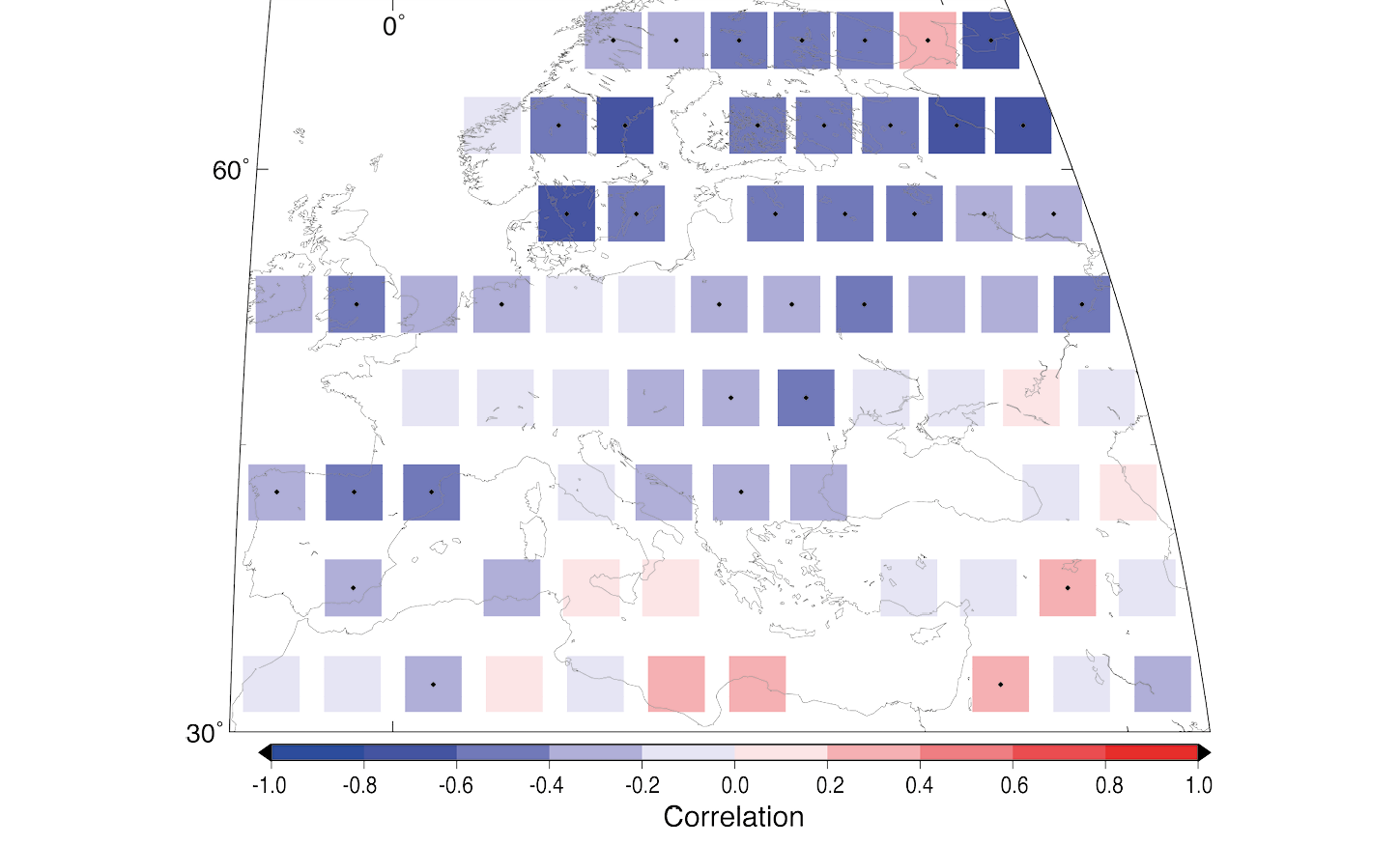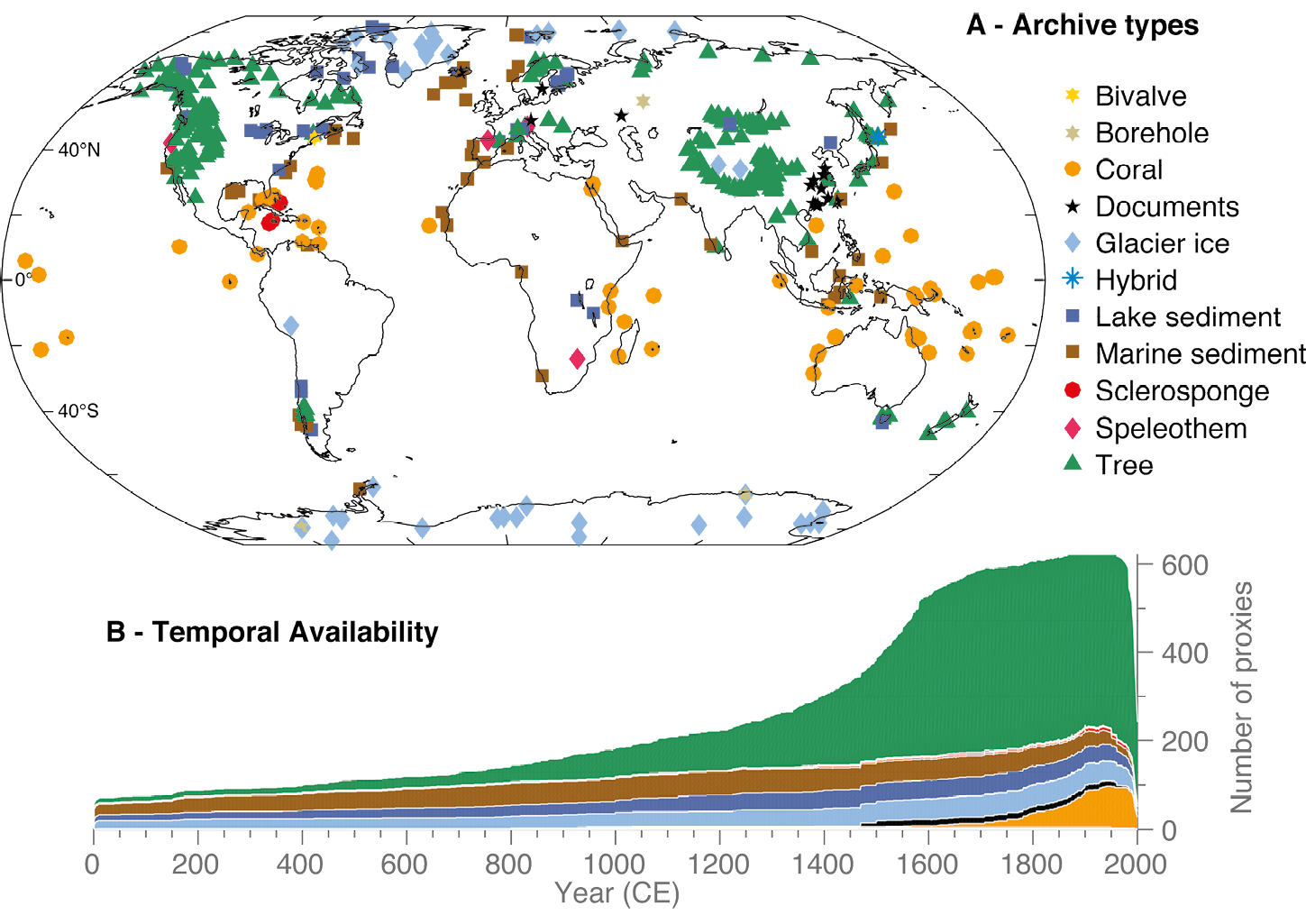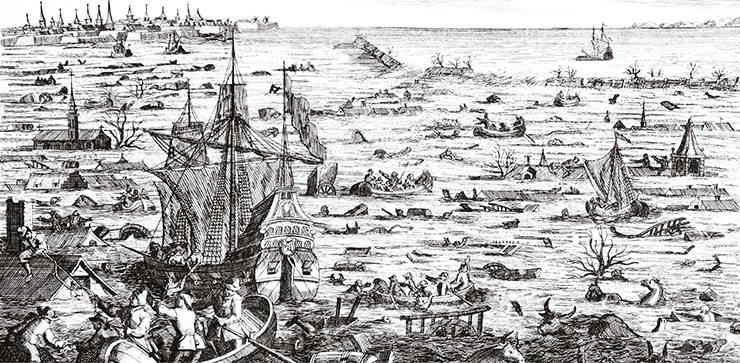- Home
- Taxonomy
- Term
- PAGES Magazine Articles
PAGES Magazine articles
Publications
PAGES Magazine articles
2017
Past Global Changes Magazine
Angelica Feurdean1 and Boris Vannière2
GPWG2 workshop, Frankfurt am Main, Germany, 5-8 December 2016
This workshop sought to expand the scope of the Global Paleofire Working Group (GPWG2), both by introducing the Global Charcoal Database (GCD; www.paleofire.org) to potential new contributors and users from Central and Eastern Europe, and to encourage them to present their datasets and initiate collaborative research using the GCD database. Twenty-six attendees, almost half early-career researchers, with expertise in past fire, vegetation, anthropogenic impact, land-cover changes, and climate participated in this workshop.
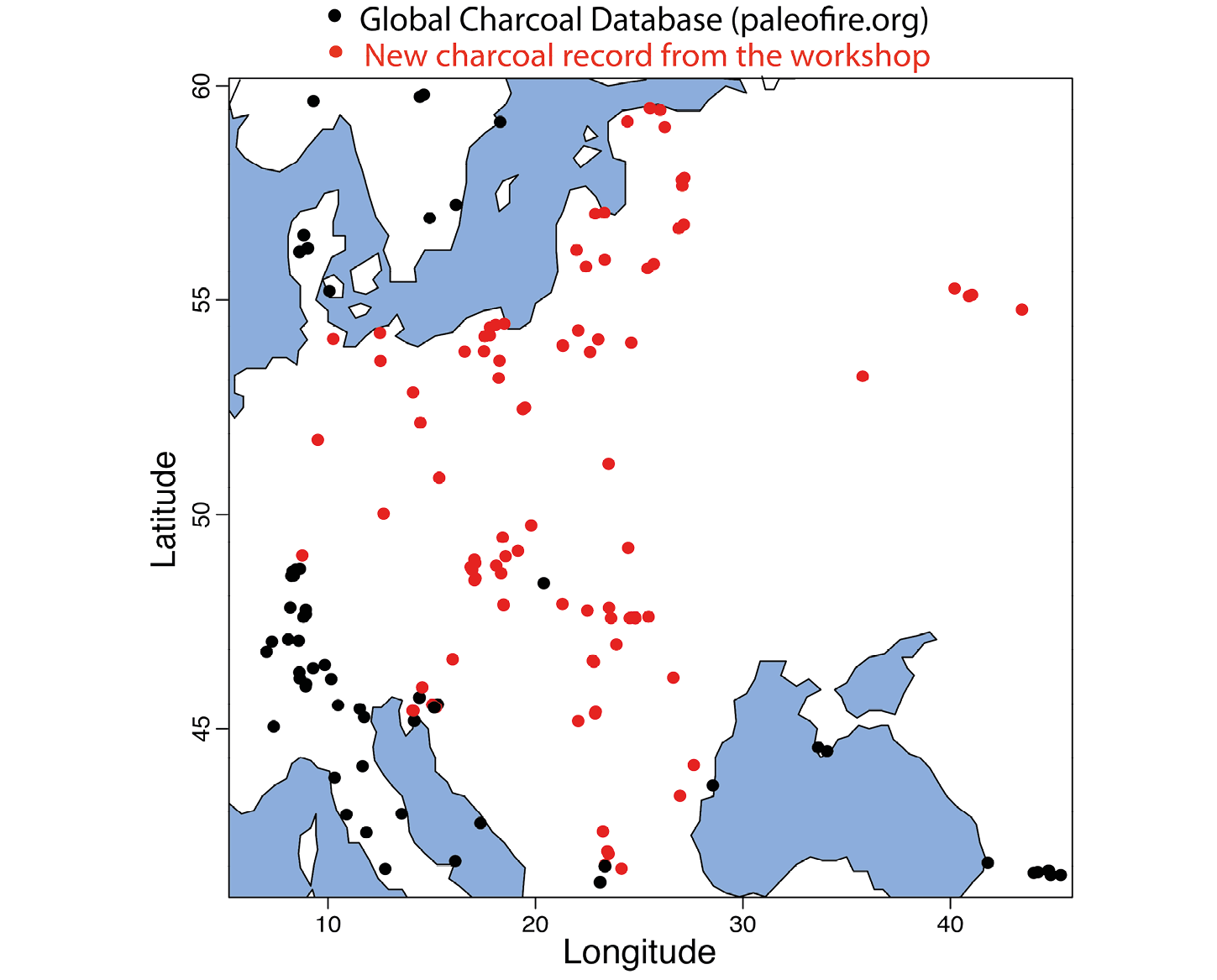 |
|
Figure 1: Distribution of our new charcoal records from Central and Eastern Europe in the Global Charcoal Database (www.paleofire.org). |
Although the continually increasing number of charcoal records in GCD has enabled a number of regional-to-global syntheses of trends in biomass burning (e.g. Marlon et al. 2016), the paucity of charcoal records from Central and Eastern Europe in the global databases has hampered a coherent synthesis of temporal pattern in biomass burning and associated fire-stakes in this region. Focusing on Central and Eastern Europe, this workshop aimed to fill the gaps in our understanding of fire-regime dynamics, under a range of past environmental conditions and anthropogenic land uses, in a region that contains fire-prone ecosystems of high conservation value on the one hand, yet lacks the knowledge of the optimal fire regimes to preserve their functioning on the other (Feurdean et al. 2017). The first session introduced the attendees and facilitated familiarization with the datasets available for the reconstruction of past fire activity in Central and Eastern Europe. The second session combined both instruction and hands-on statistical tool use with the GCD and “paleofire” R-package (Blarquez et al. 2014), to develop regional syntheses of patterns in past fire activity. To achieve this, all attendees brought and compiled almost 50 new charcoal datasets from Central and Eastern Europe to produce the very first sub-regional-to-regional paleofire synthesis for this part of Europe (Fig. 1). The third session was dedicated to sub-group and plenary discussions covering three key topics: (i) the interpretation of the preliminary regional and sub-regional cumulative curves; (ii) plenary lectures on proxy-based and modeled Holocene variation in climate conditions, land cover and population density changes; offering a background on the past environmental conditions and level of anthropogenic impact; and (iii) discussions related to statistical approaches to charcoal time series analyses and charcoal counting methodologies. A common theme in discussions was the importance of disentangling natural from human-driven fires, the role of anthropogenic fire on landscape dynamics, and the effects of fire on vegetation.
Our preliminary results over the entire region indicate the following major phases in the trajectory of fire activity over the Holocene: the highest fire activity between 10-8 ka; a low activity between 8-3 ka; a re-increase in fire activity from 3 ka towards the modern times before a final decrease over the last century. Interestingly, separated in two regions, Central and Eastern Europe show a distinctly different pattern in fire activity during the late Holocene; a decline in Central Europe as opposed to an increase in Eastern Europe. Following the workshop, we augmented this new Central and Eastern Europe dataset with ca. 70 additional records and metadata information, and are in the process of evaluating the sub-regional composite records against other proxy-based and modeled datasets of past climate, vegetation, and land-cover changes. In the coming months, our group will focus on examining the following key research questions: How has biomass burning varied along ecological and climatic gradients? What is the link between biomass burning and land-cover changes in this region? How has anthropogenic use of fire changed over time, for example with shifts in land-use strategies and landscape fragmentation?
We conclude that this workshop provided an excellent opportunity to introduce the GCD both to potential new contributors and users, and to address a geographical “data gap” leading to important new collaborative research. We also invite other scientists and data contributors from this part of Europe to join our research initiative.
affiliationS
1Senckenberg Biodiversity and Climate Center, Frankfurt am Main, Germany
2Laboratoire Chrono-environnement UMR CNRS, Besançon, France
contact
Angelica Feurdean: angelica.feurdean gmail.com
gmail.com
references
Blarquez O et al. (2014) Comput Geosci 72: 255-261
Publications
PAGES Magazine articles
2017
Past Global Changes Magazine
Marcel Mîndrescu1,2 and Ionela Grădinaru1,2
Cluj-Napoca, Romania, 23-24 May 2016
The projected climatic changes and increasing anthropogenic pressure by the end of this century are generating global concerns about the potential impacts on environment and society. Most environments are currently shaped by the interactions between the changing climate and human disturbances, therefore understanding environmental dynamics cannot be achieved without considering both climatic and anthropogenic drivers (Dearing et al. 2015).
An increasing number and diversity of paleoclimatic studies spanning the Holocene have indicated that climate underwent complex developments that rarely followed larger spatial scale patterns (e.g. Wenniger et al. 2009). However, at continental levels the cohesion of climatic shifts was documented to increase, as more and more archives, unevenly distributed across Europe, contributed to the state of knowledge.
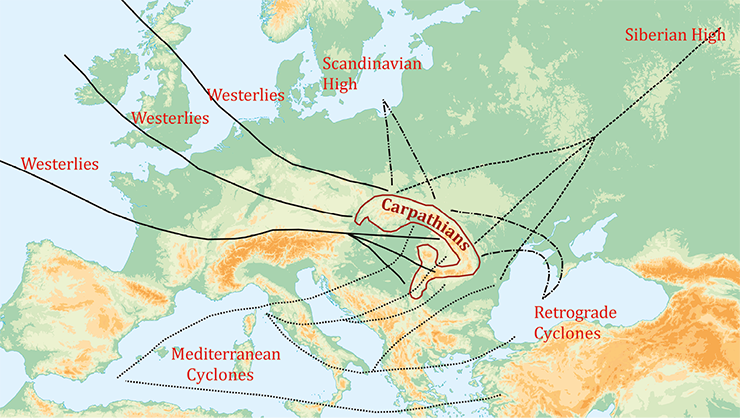 |
|
Figure 1: Relief map of Europe with the location of the Carpathian range (dark red contour line) and schematic representation of the main atmospheric circulation patterns in the region. |
As part of the continental scale, Central and Eastern (CE) Europe has only recently entered the continental ensemble of paleoclimatic reconstructions, despite its significant potential given by the geographic location, at the junction of major air masses (i.e. Atlantic, Mediterranean and Siberian) which shaped a landscape with strong climatic regimes, and landform heterogeneity. Moreover, in this region lies the last orographic barrier of Europe, the Carpathians, beyond which Eastern climatic influences are most strongly felt, thus converting the Carpathian range into an area of climatic transition (Fig. 1).
The location and layout of the Carpathians, which interfere to a significant degree with the latitudinal advection of air masses (Baltic to Mediterranean and vice versa: from sea to sea), and, more prominently, with the longitudinal circulation (Atlantic to Ural and vice versa), have been a key factor for understanding past and current climate changes in the region (Fig. 1). The Carpathian influences include both long-ranging effects (decreasing air humidity and precipitation eastward, detaining drier, more continental Eastern air masses) and local effects (the Carpathians breezes, thermal inversions, foehn winds, etc.), which factor into the climatic heterogeneity of the region.
Although the climate of the past, especially for the last millennium, and its relationship to human activities has been extensively studied, there remains a paucity of paleoenvironmental information over significant geographical areas, including CE Europe (Florescu et al. 2017). Therefore, in order to support paleoenvironmental research conducted in the region by local and foreign scientists, a PAGES-supported conference was organized in 2016, focusing on climate changes in CE Europe and their implications at various scales: Central and Eastern Europe Paleoscience Symposium: From Local to Global - CEEP 2016. The event, attended by local and foreign researchers, senior and young scientists, stakeholders, policy makers and natural parks officers, addressed paleoclimatological and paleoenvironmental research and coincided with PAGES' annual Scientific Steering Committee (SSC) meeting.
The symposium comprised six sessions focused on: Coordinated global change research; The climate system from a paleo perspective; Landscapes, biota and biosphere interactions; Interactions between humans and the environment; Outreach - communicating past global change research to stakeholders; and Thresholds and extremes as examples of PAGES’ integrative activities. The event was attended by 120 participants, of which 70 presented their contributions (39 oral presentations and 31 posters), from 22 countries. The abstracts for all the contributions were published in a special volume of Georeview Journal (http://georeview.ro/ojs/index.php/revista/issue/view/24). Some of the contributions presented at the symposium will also be published in a special issue “European Paleoscience” of Quaternary International (in prep.).
The meeting was held between May 20 and 26, which included PAGES’ SSC meeting and a field trip which took participants to the Apuseni Mountains. The main site of interest there was the Scărişoara Ice Cave (700 m long, 105 m deep, 1165 m asl), famous for the world’s largest (100000 m³, 22.5 m thick) and one of the oldest (ca. 10.500 BP) cave ice deposits (Racoviţă and Onac 2000). The duration and tone of the meeting were favorable for scientific interaction and the exchange of ideas, as well as acquainting participants with Romania’s natural environment and traditions, which could perhaps be listed among the greatest achievements of this conference.
affiliationS
1Department of Geography, University of Suceava, Romania
2Geoconcept Association of Applied Geography, Suceava, Romania
contact
Marcel Mîndrescu: marcel.mindrescu gmail.com
gmail.com
references
Dearing JA et al. (2015) Anthropocene Rev 2: 1-27
Florescu G et al. (2017) Palaeogeogr Palaeoclim Palaeoecol 473: 26-40
Racoviţă G, Onac BP (2000) Scărişoara Glacier Cave. Monographic Study. Editura Carpatica, 140 pp
Publications
PAGES Magazine articles
2017
Past Global Changes Magazine
Ulf Büntgen1,2,3, A. Kirdyanov4,5, E. Vaganov4,5 and workshop participants6
Krasnoyarsk, Russia, 10-14 April 2017
Attended by 45 scholars from seven nations, this first PAGES 2k Network workshop in the world’s largest country took place at the Siberian Federal University in Krasnoyarsk, Russia. Timely aspects of archaeology, biogeochemistry, climatology, ecology, history, and epidemiology were catalyzed in 20 stimulating talks. Focusing on the available paleo-evidence from Inner Eurasia, the authors not only devoted critical discussion to data-inherent and methodological-induced limitations, but also prioritized future research avenues towards a better understanding of environmental and societal changes throughout much of the Holocene.
A cross-disciplinary mapping project was launched as a direct outcome of this meeting, with great enthusiasm from all participants expected to translate into a unique database. Considering the greater Altai region as a nucleus for sociocultural evolution, two geographical domains have been defined: A core region from 60-120°E and 40-60°N, as well as a wider expanse from 30-150°E and 40-60°N. Following on from the LALIA concept (Büntgen et al. 2016, 2017), the database will comprise information from archaeological findings, disease outbreaks, genetic structures, glacier dynamics, ice cores, lake sediments, pollen profiles, trade routes, tree rings, and written sources (Fig. 1). Output from externally forced, coupled climate-model simulations of the last 2000 years is anticipated to provide mechanistic understanding of the underlying processes of past climate dynamics and their potential direct and indirect influences on environmental conditions, as well as trends and extremes in the socio-political and economic behavior of ancient societies (Büntgen and Di Cosmo 2016). Operating across different spatiotemporal scales, our interdisciplinary approach aims to answer the question: “How did climate change affect the rise and demise of Eurasia’s nomadic steppe empires?”.
In addition to its long-term goal, the consortium-driven workshop appeared particularly timely, because the ongoing and predicted rate of environmental and climatic change not only implies urgent research needs, but also offers a wide arena for (re)activating collaborations between Russia and the international scientific community (Büntgen 2014). Despite a variety of economic and logistic challenges, as well as political and administrative caveats, the workshop will hopefully contribute to mitigate deterioration of Russia’s academic landscape, and to facilitate access to, and exploring of, a wealth of unique paleo-archives (Büntgen et al. 2014). Scholars from all disciplines and countries are kindly invited to strengthen the momentum and join any follow-up action.
affiliationS
1Department of Geography, University of Cambridge, UK
2Swiss Federal Research Institute WSL, Birmensdorf, Switzerland
3Global Change Research Centre and Masaryk University, Brno, Czech Republic
4Sukachev Institute of Forest SB RAS, Krasnoyarsk, Russia
5Siberian Federal University, Krasnoyarsk, Russia
6List and picture of all workshop participants under: pastglobalchanges.org/calendar/all-events/127-pages/1622
contact
Ulf Büntgen: ulf.buentgen geog.cam.ac.uk
geog.cam.ac.uk
references
Büntgen U et al. (2014) Holocene 24: 627-630
Büntgen U (2016) Clim Res 70: 95-98
Büntgen U, Di Cosmo N (2016) Sci Rep 6: 25606
Büntgen U et al. (2016) Nature Geosci 9: 231-236
Büntgen U et al. (2017) Nature Geosci 10: 243
Churakova (Sidorova) et al. (2014) Glob Plan Change 122: 140-150
Publications
PAGES Magazine articles
2017
Past Global Changes Magazine
Fredrik Charpentier Ljungqvist1,2, P.J. Krusic3,4, J. Luterbacher5, J.F. González-Rouco6, E. García Bustamante7, C.A. Melo Aguilar6 and J.P. Werner8
Euro-Med2k workshop, Stockholm, Sweden, 1-2 December 2016
This workshop, hosted by the Bolin Centre for Climate Research and Department of Physical Geography at Stockholm University, marks the successful conclusion of Phase 2 of the PAGES Euro-Med2k working group. The objectives of the meeting were (1) to identify and document summer temperature and drought co-variability across Europe and the Mediterranean over the past millennium, and (2) to discuss opportunities for continuing the Euro-Med2k mandate after 2016.
Variations in the spatio-temporal distribution of droughts during past warm and cold periods arguably provide tentative information about future changes in European droughts associated with global warming. In light of recent progress in developing high-resolution European climate reconstructions, it is now, for the first time, possible to assess the co-variability between summer temperature and drought frequency and severity over the past millennium. To realize this goal, we use an updated version of the Old World Drought Atlas (OWDA; Cook et al. 2015), with its spatially resolved, tree-ring-based, summer drought index for the European-Mediterranean area extending back two millennia, and an updated version of the spatially resolved summer temperature reconstruction from tree-ring and historical documentary data by Luterbacher et al. (2016) extending back to 755 AD.
F. C. Ljungqvist opened the workshop by presenting the research background and a suggested outline for a proposed contribution to Climate of the Past. In this context, two recent studies by Hao et al. (2016) and Rehfeld and Laepple (2016) of East Asia were highlighted. Hao et al. (2016) found that hydroclimate patterns have varied considerably between different warm periods in eastern China over the past 2000 years. Rehfeld and Laepple (2016) found that the linkage between temperature and precipitation over Asia is timescale dependent, and that model simulations agree with proxy data on shorter timescales but disagree on longer timescales. These results, together with the Northern Hemispheric proxy–model comparison by Ljungqvist et al. (2016), indicate that the hydroclimate responses to low-frequency temperature changes are not yet sufficiently well known.
The Euro-Med2k group is committed to reduce this knowledge gap for the European-Mediterranean area by analyzing, in space and time, linkages between (1) 20th century instrumental temperature and drought data, (2) the gridded European temperature and drought reconstructions from 850 AD to the present, and (3) climate model simulations of summer temperature and soil moisture and precipitation from 850 AD to the present. It was decided to assess the co-variability from inter-annual to sub-centennial timescales, and to investigate potential changes in the dominant patterns of co-variability in relation to, or in tandem with, the timescales chosen. Preliminary results suggest that the co-variability between temperature and drought depends on the timescales chosen. Figure 1 shows an example of the correlations between simulated summer temperature and soil moisture over AD 850 to 1850 in Europe using the CCSM4 model.
The second part of the workshop was devoted to working in smaller groups with different tasks related to setting up experiments, discussing methods, and data–model intercomparisons. During the workshop, P. J. Krusic presented outlines for a new project regarding “European streamflow and drought: Continental scale outputs of the hydrological cycle”. In a further presentation, J. Luterbacher talked about the Tambora eruption in April 1815 and the subsequent “year without a summer 1816”, summarizing the current state of knowledge related to summer temperature and drought anomalies across different areas of the globe.
The last part of the workshop was devoted to discussions related to future collaborations within the Euro-Med2k working group after its official end in 2016. An agreement was reached to continue as an independent consortium, preferably in collaboration with PAGES, aiming for one meeting per year arranged by its members and their institutions. Over the past few years, Euro-Med2k has taken advantage of the spinoffs between the proxy and paleo-model communities and this was agreed to be an important aspect to continue pursuing.
affiliationS
1Department of History, Stockholm University, Sweden
2Bolin Centre for Climate Research, Stockholm University, Sweden
3Department of Geography, University of Cambridge, Cambridge, UK
4Department of Physical Geography, Stockholm University, Sweden
5Department of Geography, Climatology, Climate Dynamics and Climate Change and Centre of International Development and Environmental Research, Justus Liebig University of Giessen, Germany
6Department of Astrophysics and Atmospheric Sciences, Universidad Complutense de Madrid, Spain
7Unidad de Energía Eolica, Centro de Investigaciones Energéticas, Medioambientales y Tecnológicas (CIEMAT), Madrid, Spain
8Department for Earth Science and Bjerknes Centre for Climate Research, University of Bergen, Norway
contact
Fredrik Charpentier Ljungqvist: fredrik.c.l historia.su.se
historia.su.se
references
Cook ER et al. (2015) Sci Adv 1: e1500561
Hao Z et al. (2016) Int J Climatol 36: 467-475
Ljungqvist FC et al. (2016) Nature 532: 94-98
Publications
PAGES Magazine articles
2017
Past Global Changes Magazine
Bronwen Konecky1, L. Comas-Bru2 and E. Dassié3
Iso2k Science Team Meeting, Zaragoza, Spain, 14-15 May 2017
Much of our understanding of Earth’s hydro-climate history comes from proxies for the δ18O and δD of environmental waters (e.g. precipitation, seawater, groundwater, lake water, permafrost, ice; Smerdon et al. 2017). The δ18O and δD of environmental waters are recorded by sensors in a range of natural archives, such as glacier and ground ice, speleothems, corals, sclerosponges, lake and marine sediments, and tree rings. Despite this diversity, reconstructed δ18O and δD can track common environmental signals such as moisture source and air mass transport history, precipitation characteristics, and temperature (Dansgaard 1964), and thus provide invaluable comparison targets for global climate models (Schmidt et al. 2014). However, no comprehensive synthesis of proxy δ18O or δD yet exists in a format suitable for regional-scale climate reconstructions or for data-model comparisons.
The PAGES Iso2k project is creating a global database of paleo-δ18O and δD records for the Common Era based on a range of archives, with resolutions from annual to centennial, and with extensive metadata fields to facilitate interpretation and uncertainty quantification of the emergent hydroclimate signal(s). The database is being used to identify regional- and global-scale features in hydroclimate and atmospheric circulation as well as their relationship with temperature reconstructions. As a formal project within the framework of PAGES 2k Network Phases 2 and 3, the Iso2k effort is currently the only global, multi-archive hydroclimate database being constructed for the Common Era, with strong ties to other archive and climate target-specific groups within PAGES. Iso2k comprises the first steps towards a broader “Hydro2k” synthesis.
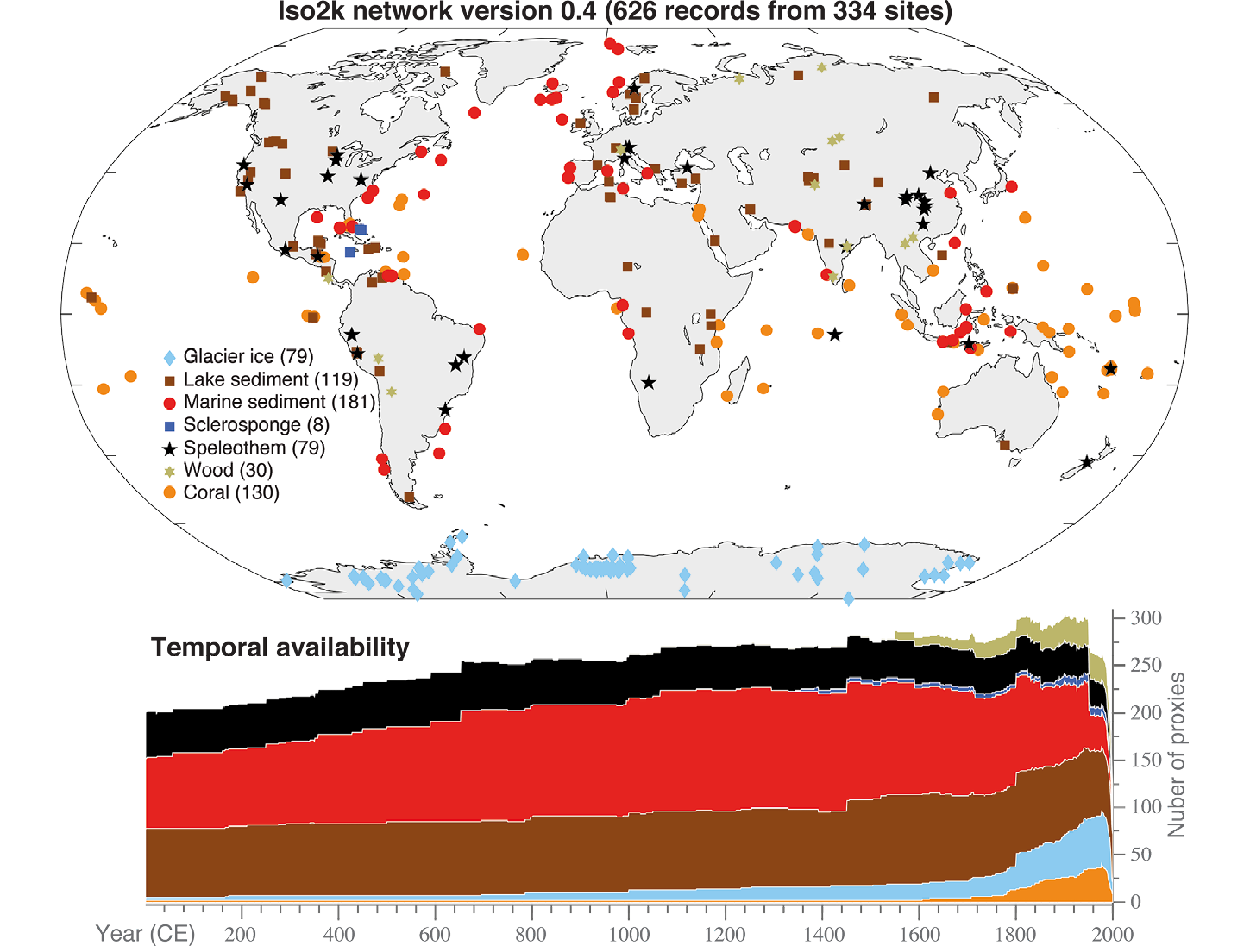 |
|
Figure 1: Status of the beta Iso2k database in June 2017. Symbols: records that have been both entered and quality-controlled. Figure courtesy of Nick McKay. |
Twenty-eight Iso2k members from ten countries, including 15 early-career scientists, met for the first in-person Iso2k Science Team Meeting. This meeting followed two years of productive, consensus-driven, tele-collaboration. The meeting took place at the CSIC (Consejo Superior de Investigaciones Científicas) Offices in Zaragoza, Spain, directly following the 5th PAGES Open Science Meeting. The main goals of the workshop were to evaluate climatic/isotopic patterns that are emerging from the “beta” version of the database (Fig. 1), which was created in early 2017, and to troubleshoot metadata and quality control issues.
To stimulate the most productive discussion possible, prior to the workshop five small “buddy groups” were formed, each containing workshop participants and other Iso2k members who shared similar interests. These groups explored themes of broad interest for the Iso2k community: modes of variability in the high latitudes, the tropical Pacific, and the Atlantic; global comparisons with PAGES 2k temperature reconstructions; and isotope-enabled model-data comparisons. On Day 1, each group shared preliminary figures using the Iso2k database to evaluate climatic and isotopic patterns in space and time. These presentations formed the basis of the ensuing group discussion, in which participants identified the highest-priority scientific questions that will be addressed using the database. Participants also strategized about pressing metadata and data quality issues that needed to be resolved in order to address each scientific question.
Day 2 of the workshop was dedicated to the “nitty-gritty” of Iso2k: quality control, metadata, and future plans. Key points were drafted to serve as the structure for the group’s first scientific papers. A mini “hackathon” allowed participants to revisit and expand on analyses presented on Day 1. Next, the group broke out into small metadata and data quality “task forces” to tackle pressing quality control issues that surfaced the previous day. After a final wrap-up discussion of next steps and a project timeline, the workshop adjourned.
For more information about Iso2k or to get involved, visit our website at pastglobalchanges.org/science/wg/2k-network/projects/iso2k/intro
affiliationS
1Cooperative Institute for Research in Environmental Sciences, University of Colorado Boulder, USA
2UCD School of Earth Sciences, University College Dublin, Ireland
3Lab. d'Océanographie et du Climat: Expérimentations et Approches Numériques (LOCEAN – IPSL), Université P. et M. Curie, Paris, France
contact
Bronwen Konecky: bronwen.konecky colorado.edu
colorado.edu
references
Dansgaard W (1964) Tellus 16(4): 436-468
Schmidt GA et al. (2014) Clim Past 10(1): 221-250
Smerdon JE et al. (2017) Clim Past Discuss, doi:10.5194/cp-2017-37
Publications
PAGES Magazine articles
2017
Past Global Changes Magazine
PAGES 2k Network Coordinators*
Zaragoza, Spain, 11 May 2017
The PAGES 2k Network was created with the aim of reconstructing changes in regional and global surface climate over the past 2000 years. During Phases 1 (2008-2013) and 2 (2014-2016), regional and trans-regional groupings focused on building reconstructions for terrestrial regions and the oceans. The conclusion of Phase 2 coincided with the release of an open and transparent global database of temperature-sensitive proxies spanning the Common Era (Fig. 1; PAGES 2k Consortium 2017). This product will be followed up by a special issue of Climate of the Past, entitled “Climate of the past 2000 years: regional and trans-regional syntheses” (www.clim-past.net/special_issue841.html).
The third phase of the PAGES 2k Network was launched in May 2017 at the PAGES 5th Open Science Meeting (OSM). In this new phase, we aim to address major questions centered on past hydroclimate, climate processes and proxy uncertainties, with three distinct scientific themes:
- Theme 1 (Climate Variability, Modes and Mechanisms) aims to further understand the mechanisms driving regional climate variability and change on interannual to centennial time scales.
- Theme 2 (Methods and Uncertainties) aims to reduce uncertainties in the interpretation of observations imprinted in paleoclimatic archives by environmental sensors.
- Theme 3 (Proxy and Model Understanding) aims to identify and analyze the extent of agreement between reconstructions and climate model simulations.
At the OSM, anyone interested in the network was invited to a lunchtime meeting. The goals of this meeting were to present the framework for Phase 3, introduce the new coordination team, present proposals for new projects, and collect ideas for additional Phase 3 activities.
To stimulate new ideas for projects, a “Post-It” note exercise was held, where participants were asked to nominate scientific questions they would like PAGES 2k to address. This exercise led us to identify five themes that sparked widespread interest, and which could serve as foci for potential Phase 3 projects: (i) the combination of high- and low-resolution proxies; (ii) data stewardship and script availability; (iii) data-model comparison; (iv) the evolution of the mid- to high-latitude Southern Hemisphere climate; and (v) the hydrological cycle, temperature-hydroclimate co-variability and interannual to interdecadal variability. Participants split into groups to discuss potential projects in each of these fields.
The overall structure of PAGES 2k consists of a network of projects, each organized and led by members of the community. So far, nine projects have begun their activities. These are either trans-regional projects that have transitioned from Phase 2, or new projects that have been proposed and endorsed as part of Phase 3. Examples of Phase 3 projects include: Clivash2k, which will generate a community-based multi-proxy reconstruction of key modes of Southern Hemisphere variability over the past 2000 years; and Iso2k, which started its activities during Phase 2 and aims to create a global database of paleo-δ18O and δD records. New projects can be proposed at any time.
Phase 3 of the PAGES 2k Network will run until 2020 and is open to anyone who is interested. There are a number of ways to participate: by contributing your data or expertise, by initiating a new project or by participating in an existing one. If you would like to participate in PAGES 2k, please contact us. To receive updates on our activities, sign up for the mailing list at https://listserv.unibe.ch/mailman/listinfo/pages2k.pages
For further information on the PAGES 2k Network, including details of existing projects and the procedure for proposing a new one, please see pastglobalchanges.org/science/wg/2k-network/intro
affiliationS
*N. Abram (Australian National University, Australia), O. Bothe (Helmholtz-Zentrum Geesthacht, Germany), H. Linderholm (Gothenburg University, Sweden), B Martrat (Spanish Council for Scientific Research, Spain), H. McGregor (University of Wollongong, Australia), R. Neukom (University of Bern, Switzerland), S. Phipps (University of Tasmania, Australia), S. St George (University of Minnesota, USA), L. von Gunten (PAGES IPO, Switzerland).
contact
Lucien von Gunten: lucien.vongunten pages.unibe.ch
pages.unibe.ch
references
Publications
PAGES Magazine articles
2017
Past Global Changes Magazine
Hugues Goosse1 and Blas Valero-Garcés2
Zaragoza, Spain, 10 May 2017
In 2016, PAGES launched a new integrated initiative with the goal to improve the coordination between different communities working on past extreme events such as hurricanes, storms, droughts and floods. The initiative wants to stimulate new lines of research and facilitate the transfer of relevant information, in particular to the users and stakeholders dealing, up to now, mainly with more recent events. A lunchtime session took place during the PAGES 5th Open Science Meeting in Zaragoza to receive the inputs of the community on the proposed activities, to suggest additional ones and discuss a timeline for the implementation of the first actions.
The group reiterated the large interest of studying past extreme events: they are important elements of the climate system whose dynamics need to be better understood; they have a large impact on environment and societies, and thus attract strong attention from many stakeholders, including the general public; and paleoscience offers the only possibility to analyze a wide range of observed realizations of those generally rare events.
Despite the larger number of activities on past extreme events, establishing links between them did not appear straightforward. As a first step, it was proposed to prepare a short glossary, giving a common definition of the main terms, such as what each of us mean by extremes, probability compared to possibility, etc., in order to facilitate the discussions. To gather input from the whole community, this will take the form of a Wiki page, on the web page of the Extremes Integrative Activity (pastglobalchanges.org/science/int-act/extremes). A second action is to prepare a document on the PAGES website describing existing research on past extremes and presenting a few key results, with a specific link to the PAGES working groups active in the domain.
Another important point that was raised during the meeting and in subsequent discussions is that strong links need to be maintained and developed between communities working on past extremes and on more recent ones. In this framework, the World Climate Research Program (WCRP) Extremes Grand Challenge (wcrp-climate.org/grand-challenges/gc-extreme-events) and the Future Earth KAN on emergent risks and extreme events, the follow up to the Future Earth initiative on “Extreme events and environments – from climate to society (E3S)“ (futureearth.org/extreme-events-and-environments-climate-society-e3s) are two clear opportunities of collaboration that will be actively pursued.
After those initial steps, a workshop will be organized in the first half of 2018, likely in collaboration with some WCRP and Future Earth partners, with the objective to determine the best way to synthesize the existing work on past extremes and, in particular, to contribute to assessments such as those proposed in the framework of the Intergovernmental Panel on Climate Change (IPCC).
The plans are still very open at this stage. If you are interested in this subject, you can join the mailing list of the Integrative Activity (https://listserv.unibe.ch/mailman/listinfo/extremes.pages), contribute to the Wiki page and send information to the activity coordinators, describing results that can be included on the web page or any suggestions that you consider useful to move the activity forward.
affiliationS
1Earth and Life Institute, Université catholique de Louvain, Louvain-la-Neuve, Belgium
2Pyrenean Institute of Ecology, Spanish National Research Council, Zaragoza, Spain
contact
Hugues Goosse: hugues.goosse uclouvain.be
uclouvain.be
Publications
PAGES Magazine articles
2017
Past Global Changes Magazine
Blas Valero-Garcés1, A. Moreno1, P. González-Sampériz1, G. Gil-Romera1 and Local Organizing Committee2
PAGES Open Science Meeting, Zaragoza, Spain, 9-13 May 2017
The PAGES community met in Zaragoza, Spain, in May 2017 for the 5th Open Science Meeting (OSM). The meeting was organized by the Pyrenean Institute of Ecology, a research center of the Spanish National Research Council, with the collaboration of the University of Zaragoza. The city of Zaragoza is famous for the World Heritage Mudejar architecture, a syncretic art developed in the Christian kingdoms by Muslim artisans. The Mudejar star, the 2017 OSM logo, was chosen as a reminder of the positive outcomes when diverse minds and cultures meet.
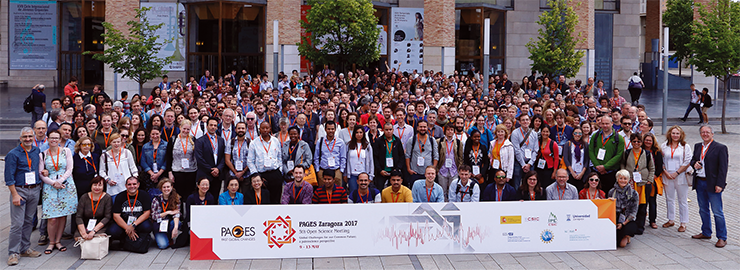 |
|
Figure 1: Subset of the over 900 OSM participants in front of the venue in Zaragoza, Spain. |
Over 900 delegates (44% female) from 56 countries participated in 33 sessions (with up to six parallel sessions). In total, more than 980 communications were presented as posters (646) and talks (338). In addition, nine PAGES and affiliated working groups had meetings before, during and after the OSM. Lunch was served in the Auditorium to all participants in a wifi-free environment to promote interactions, sharing of new ideas, and some relaxation after the intense morning sessions. Science and Somontano wine helped to maintain lively discussions during the poster sessions.
Eight plenary speakers gave us the state-of-the-art in ocean warming (Nerilie Abram, Australia), geoinformatics (Julien Emile-Geay, USA), climate system variability (Gabriele Hegerl, UK), climate evolution of the Western Mediterranean (Isabel Cacho, Spain), interglacials (Erik Wolff, UK), greenhouse gases variability (Ed Brook, USA), human evolution and climate (Juan Luis Arsuaga, Spain) and the interactions of climate, vegetation and humans in the Iberian Peninsula (Penélope González-Sampériz, Spain).
The meeting structure, with its 33 sessions, was built around PAGES’ scientific themes of climate, environment and humans. Also well represented were the strengthened connections between PAGES working groups and the increasing importance of interdisciplinary approaches in paleoscience. Particularly well attended were the sessions on the Southern Hemisphere, the Mediterranean, the climate of the last two millennia (2k) and Quaternary interglacials.
The Local Organizing Committee organized two outreach events: A film night with Leonardo DiCaprio's climate change documentary "Before the Flood"; and a Round Table, open to the public and led by politicians and scientists, on the topic “Climate change: from global to local challenges.”
Social activities included the ice breaker with music by the O´Carolan Quintet, the conference dinner with subsequent disco, and a free visit to the Aljafería Palace. After the long scientific sessions, delegates strolled the city parks and the Ebro River, enjoyed light tapas dinners in bars and terraces downtown, and visited the museums and old buildings to get a taste of the city’s rich culture. Four teams, representing modelers and proxies, played in the traditional PAGES Cup football (soccer) match, held in the José Antonio Labordeta Park. In spite of cloudy skies and mosquitoes, free beer and enthusiastic fans kept the sport spirit high (Ashastina and Alexandroff 2017).
For a few days, paleoscientists flooded Zaragoza and made the headlines in local and regional media coverage; see a selection of the many TV and print reports here: pages-osm.org/2017/osm/post-meeting-material
Field trips were conducted to the Ordesa- Monte Perdido National Park to illustrate some of the glacial features; to the Segre River and its unique paleoflood record, and to the Huerva River to show the geoarchaeology of the region.
We thank all supporters, sponsors and volunteers who helped organize and finance the 5th PAGES OSM meeting. In these times of rapid change, the OSM showcased how our science is more useful than ever for society – from citizens to politicians. We thank all the attendants for presenting their science, participating in the discussions and field trips and creating links to strengthen PAGES as a global community. We wish you all a very productive, fruitful and inspiring period to face together the challenges ahead of us until the PAGES OSM convenes again in four years.
affiliationS
1Pyrenean Institute of Ecology, Spanish National Research Council, Zaragoza, Spain
2pages-osm.org/2017/osm/organizational-structure
contact
Blas Valero-Garcés: blas ipe.csic.es
ipe.csic.es
references
Publications

PAGES Magazine articles
2017
Past Global Changes Magazine
Kseniia Ashastina1,2 and Stella Alexandroff3
The PAGES Open Science Meeting 2017 was a great conference all around - an exciting scientific program, a labyrinth of rooms and talks, great meals, networking to Spanish rhythms with red wine and a full moon. It was easy to get carried away by science rushing from one talk to the next. But two things were cemented in every head: (1) Daily lunch from 13:00-15:00 and (2) the PAGES Football Cup on 10 May at 19:30. For two days, the OSM was buzzing with questions like "Are you playing?", "In which team?", "Free beer, really?"
If you believe the common paleoscientist stereotypes, you may be forgiven for thinking that the “Proxies” scientists could have a certain advantage over the “Modelers” when it comes to outdoor sports. After all, you may picture the Modelers as physics-savvy beings who shy away from the sun and tell each other jokes in binary code. The Proxies, on the other hand, will sleep strapped to a tree branch, take their daily shower in the mud and keep confusing the words projection and prediction.
But stereotypes are stereotypes, and not suitable to predict (or project) the outcome of a football game.
The match started off very even and both teams moved gracefully on the somewhat bumpy grass pitch. It was a majestic chain of pursuit: players chased the ball, biting insects chased the players, and everyone chased free beer. While the game stayed close and suspenseful for most of its duration, it eventually became evident that the Modelers were going to win. As spectacular as some of the Proxies’ goals were – one of them was a mere by-product of the attacker stumbling over the ball and falling flat on the face – the Modelers played their way to a deserved win. In one blow, stereotypes were shattered, the Proxies’ dreams were shattered, and everyone’s skin was shattered by insects. At this point, it might be worth mentioning that the Modelers team largely consisted of Proxies, as not enough Modelers had signed up to play sports in the first place.
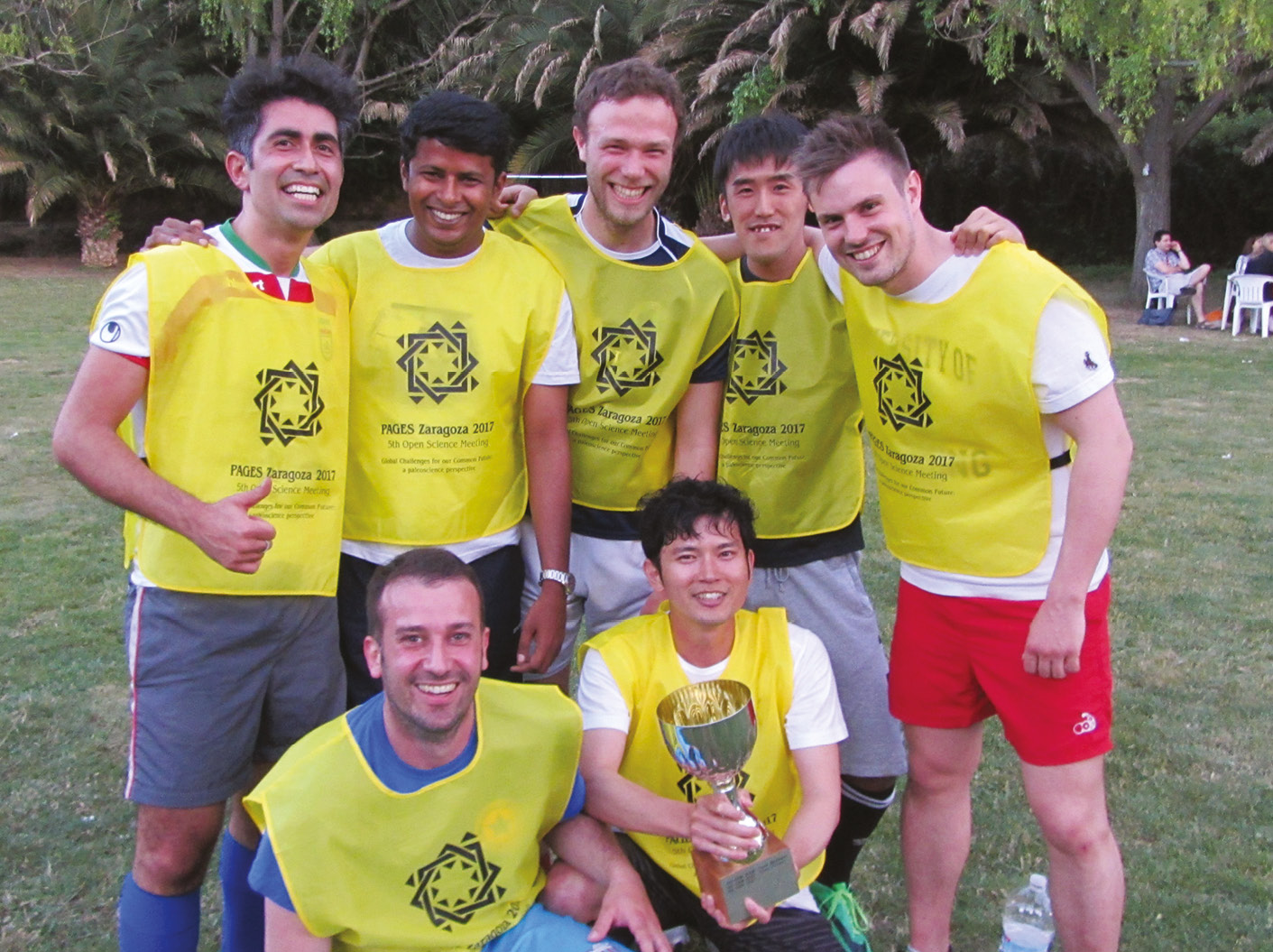 |
|
Happy winners – team Modelers - of the PAGES Football Cup 2017, 10 May, Zaragoza, Spain. |
All in all, the football cup was a great success; everybody left the pitch in a good mood after a fun evening and ready to tackle the talks and posters of the following day.
Please see some additional facts in graphic form (accuracy of information might have been affected by euphoria) ...
affiliationS
1Senckenberg Research Station of Quaternary Palaeontology, Weimar, Germany
2Institute for Systematic Botany, Friedrich Schiller University, Jena, Germany
3School of Ocean Sciences, Bangor University, UK
contact
Kseniia Ashastina: kseniia.ashastina senckenberg.de
senckenberg.de

Egos and shins may have been bruised in the battle for the PAGES Cup, but mosquitoes free beer football was the winner of the day.
Publications
PAGES Magazine articles
2017
Past Global Changes Magazine
Niina Kuosmanen1, E.J. Gowan2 and K. Braun3
The YSM meeting in Morillo de Tou offered early-career scientists three valuable workshops, where experts in their respective fields gave guidance concerning funding, communication in science and data sharing.
Workshop 1: Funding
Finding your way through different funding bodies and producing a successful funding application can be challenging in the early stages of a scientific career. Hubertus Fischer (University of Bern) gave valuable advice on how to formulate a funding proposal. He highlighted the importance of having a great idea and being able to defend it. It is also essential to know the audience to whom you are writing and to adjust your text accordingly. For example, an expert panel in charge of funding decisions will expect a different level of detail than a staffer at the funding agency or a private foundation. The recipe for a successful proposal is three “C”s: be Clear, Concise and Consistent!
Valuable information about different possible funding bodies (such as Horizon 2020 and Marie Skłodowska-Curie Actions) was provided by Pilar Calatayud (European Projects Office at the University of Zaragoza). Jonas Bunikis (European Research Council Executive Agency) provided more detailed information about applying for European Research Council (ERC) funding. He stressed the importance of learning to write good grant applications and the necessity to show your independence as a researcher. He also pointed out that the promise of excellence means highlighting the potential of making a breakthrough in your field of research.
The same topic was then also discussed within breakout groups. The participants underlined the importance of time management between research and grant application. Indeed, you might have to write several proposals before one is selected. Don’t lose patience! On the contrary, take advantage of any review received, and even ask for independent reviews to improve your proposal. Starting from a small proposal with well-defined goals and objectives and letting it evolve towards a broader research project was also a strategy that the breakout groups proposed.
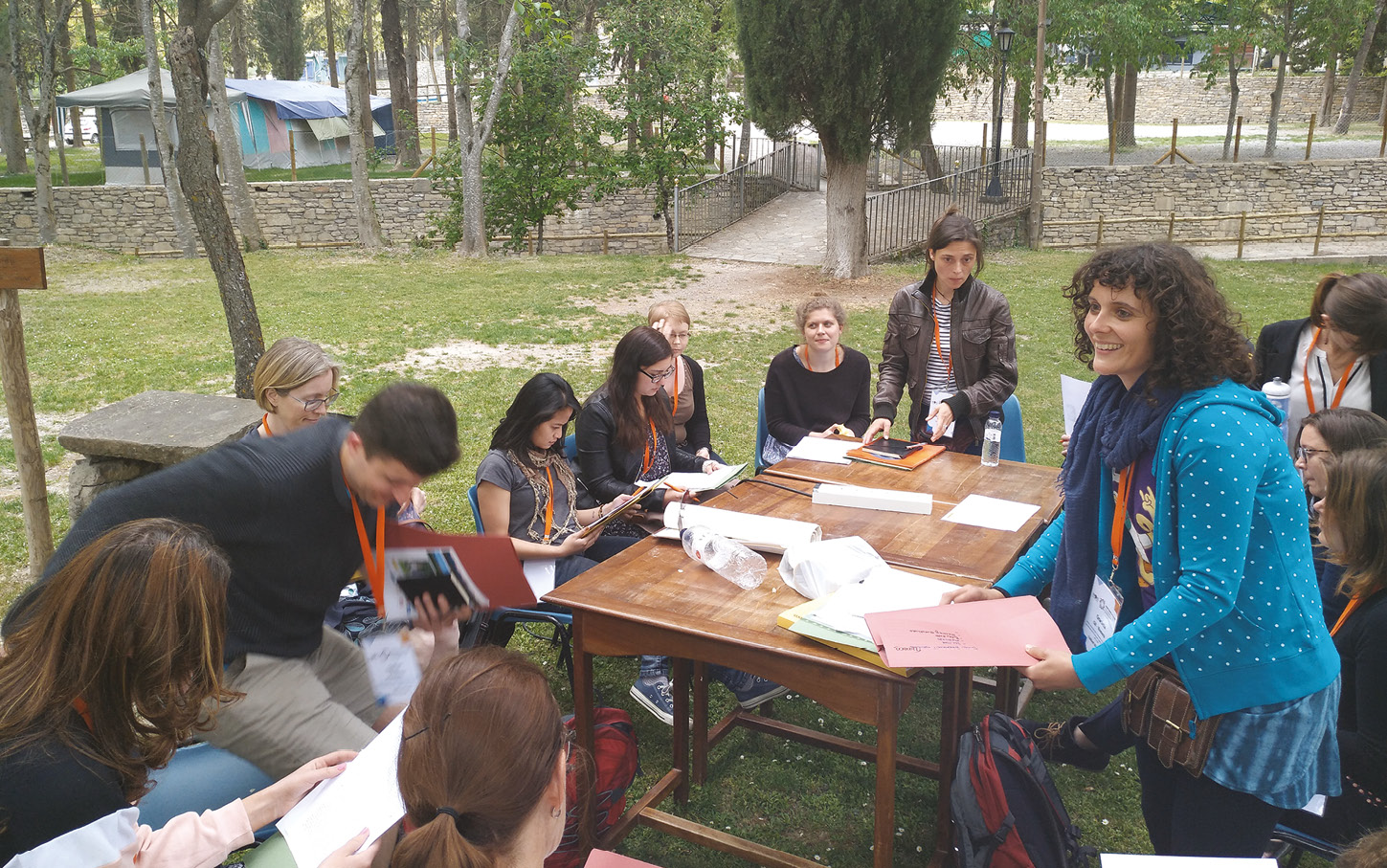 |
|
Graciela Gil-Romera, a member of the YSM Local Organizing Committee, hands out a list of possible questions for discussion at the "Communication" round-table meeting |
Workshop 2: How to communicate science
Communicating science covers many aspects from writing a research proposal to making your research understood by people who are not familiar with your field. Alicia Newton (Nature Geoscience) stressed a few questions to successfully communicate research in a focused manner: Which specific question do you want to answer? What is the purpose of your research? Why should people believe you? Knowing your audience and adapting your message to it are also crucial to be understood.
Liz Kalaugher (environmentalresearchweb) spoke about promoting your research to the media. Making your research known and being involved in outreach outside of your own research community can raise your profile and may result in more citations. However, not every study makes it to the news. Studies directly affecting people’s lives and controversial and unusual topics are most likely to get attention. Nevertheless, active promotion of your research in blogs, social media or at outreach events may increase your media exposure.
Angela Wade (PAGES) introduced the possibilities for early-career scientists to use publishing and other communication outlets within the PAGES network. One important conclusion from the discussion was the demand for more extensive workshops on science communication for early-career scientists.
Workshop 3: Data sharing
In the third workshop Darrell Kaufman (Northern Arizona University), Alicia Newton and Jonas Bunikis discussed the opportunities and challenges of sharing data. Making data freely and broadly accessible is important, because large data sets allow for questions to be tackled that cannot be answered by a single study. Data sets, even small ones, provide the means for assessing spatio-temporal patterns, conducting proxy-proxy comparisons and data-model comparisons, and identifying aberrant records. Challenges in data sharing include the often heterogeneous and multidimensional data and nuanced interpretation of different data types. Having a data management plan early in your career is essential, since both journals and funding agencies increasingly require documentation of data availability. Publication in data-oriented journals provides description for the data sets, favors the sharing and reuse of data and gives credit to those who share their data. Safe repository (for example with a certified organization) offers long-term archives for your data and easy citation.
Altogether, these three workshops provided valuable knowledge, topics for further thought and discussion, and guidance for our scientific careers.
affiliationS
1Department of Forest Ecology, Czech University of Life Sciences Prague, Czech Republic
2Alfred Wegener Institute, Bremerhaven, Germany
3Institute of Human Origins, Arizona State University, Tempe, USA
contact
Niina Kuosmanen: kuosmanen.niina gmail.com
gmail.com

